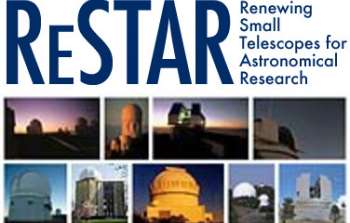sci08001 — Announcement
Program Update: ReSTAR and Beyond
January 31, 2008
ReSTAR Reports
The Senior Review report urged NOAO to ensure that community access to facilities remains scientifically balanced over all apertures, and that it do so both in the present, and in the future—into the era of Pan-STARRS, LSST, JWST, ALMA, GSMT, and the NVO. In response to this recommendation, NOAO formed a committee, ReSTAR (Renewing Small Telescopes for Astronomical Research), charged with developing a prioritized, quantitative, science-justified list of capabilities appropriate to telescopes with apertures less than 6 meters, together with estimates of the number of nights needed. The committee was asked to solicit input from the broad community in order to address current needs and uses of such telescopes and to attempt to predict how these needs will evolve over the next ten years. The ReSTAR committee concluded its work in December, 2007 and issued its recommendations. The full report can be found at the ReSTAR page on the NOAO website.
In summary, the ReSTAR report establishes the scientific importance of telescopes of small and mid-size aperture, and makes the following recommendations about the evolution of access and capabilities in order to make the US system of telescopes in this aperture range more consistent with the needs of the community.
- Renew the infrastructure of the existing federally-funded telescopes.
- Update the instrumentation on these telescopes to provide higher efficiency and effectiveness.
- Emphasize fundamental, “workhorse” instrumental capabilities—these are what the great majority of researchers want access to.
- Raise the amount of time available on 2-4m telescopes to the equivalent of about 8 telescopes; it is currently between 3 and 4, including NOAO facilities and IRTF.
- Create a network of facilities for the exploration of the time-domain; this will be needed for the community to exploit Pan-STARRS and LSST discoveries to the fullest.
- Utilize important capabilities on non-federal telescopes, but in bringing them into the system, maintain a high level of usability.
Building the ReSTAR System
In response to these recommendations, NOAO is putting together a plan that addresses all of the items above. The mountaintop infrastructure at KPNO and CTIO is already being modernized. To address the amount of access desired, we are looking at a combination of restoring complete access to our own facilities, buying time on other facilities, and building some new telescopes. We will update our existing instrumentation, starting with our spectrographs; modernization of our imaging capabilities is already well under way with NEWFIRM, ODI, and DECam. All of these efforts will be supported by our in-house programs, particularly our Instrumentation program and our Data Products program, and their approaches will emphasize partnerships with community groups. This plan will first be sketched out in a white paper that we will submit to the NSF before the end of February. At that time we will release it for public comment. Our expectation is to package this plan as a proposal to the NSF to be submitted in time to begin ramping up these activities in 2009.
The Large Telescope System
We regard the ReSTAR committee effort as having been quite successful. It elicited input from 160 astronomers through a Web survey. This input was analyzed and interpreted by the committee into a report that is thoughtful and comprehensive. Obviously, the same approach would benefit discussion of the capabilities needed on telescopes in the 6.5-10 meter aperture range, and so an analogous committee is being formed to begin this study. For the large telescope discussion, Gemini is a special case, both because it already represents the dominant access to large telescopes for the broad community and because of the recent announcement of the UK withdrawal. While the membership of this new committee has not yet been established, we are hopeful that it will complete its report before the end of 2008. Like ReSTAR, it will make the solicitation of community input a high priority. Please be aware of this activity, and when the announcement comes out, make your ideas and interests known.
About the Announcement
| Id: |
ID
sci08001
|

